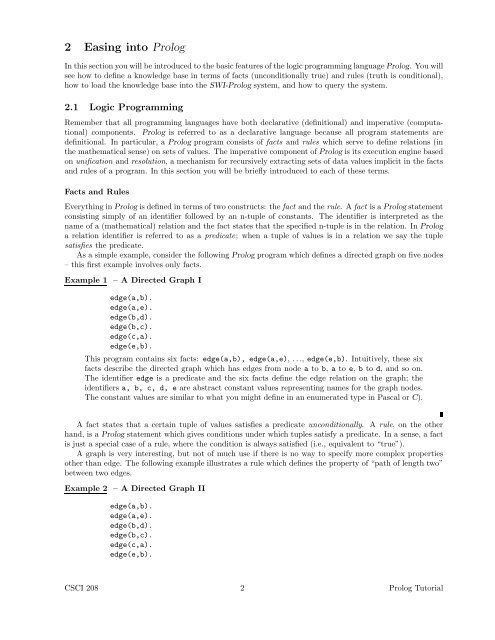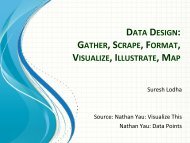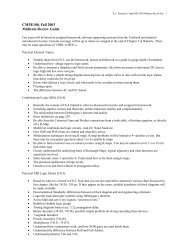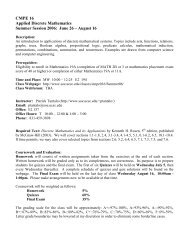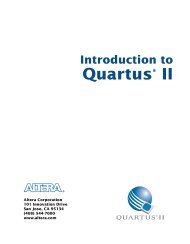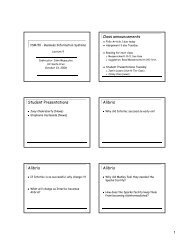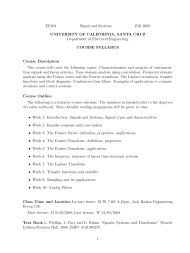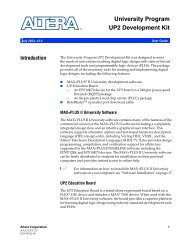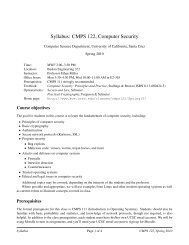Prolog A Tutorial Introduction - Courses
Prolog A Tutorial Introduction - Courses
Prolog A Tutorial Introduction - Courses
Create successful ePaper yourself
Turn your PDF publications into a flip-book with our unique Google optimized e-Paper software.
2 Easing into <strong>Prolog</strong><br />
In this section you will be introduced to the basic features of the logic programming language <strong>Prolog</strong>. You will<br />
see how to define a knowledge base in terms of facts (unconditionally true) and rules (truth is conditional),<br />
how to load the knowledge base into the SWI-<strong>Prolog</strong> system, and how to query the system.<br />
2.1 Logic Programming<br />
Remember that all programming languages have both declarative (definitional) and imperative (computational)<br />
components. <strong>Prolog</strong> is referred to as a declarative language because all program statements are<br />
definitional. In particular, a <strong>Prolog</strong> program consists of facts and rules which serve to define relations (in<br />
the mathematical sense) on sets of values. The imperative component of <strong>Prolog</strong> is its execution engine based<br />
on unification and resolution, a mechanism for recursively extracting sets of data values implicit in the facts<br />
and rules of a program. In this section you will be briefly introduced to each of these terms.<br />
Facts and Rules<br />
Everything in <strong>Prolog</strong> is defined in terms of two constructs: the fact and the rule. Afact is a <strong>Prolog</strong> statement<br />
consisting simply of an identifier followed by an n-tuple of constants. The identifier is interpreted as the<br />
name of a (mathematical) relation and the fact states that the specified n-tuple is in the relation. In <strong>Prolog</strong><br />
a relation identifier is referred to as a predicate; when a tuple of values is in a relation we say the tuple<br />
satisfies the predicate.<br />
As a simple example, consider the following <strong>Prolog</strong> program which defines a directed graph on five nodes<br />
– this first example involves only facts.<br />
Example 1 –ADirectedGraphI<br />
edge(a,b).<br />
edge(a,e).<br />
edge(b,d).<br />
edge(b,c).<br />
edge(c,a).<br />
edge(e,b).<br />
This program contains six facts: edge(a,b), edge(a,e), ..., edge(e,b). Intuitively, these six<br />
facts describe the directed graph which has edges from node a to b, a to e, b to d, andsoon.<br />
The identifier edge is a predicate and the six facts define the edge relation on the graph; the<br />
identifiers a, b, c, d, e are abstract constant values representing names for the graph nodes.<br />
The constant values are similar to what you might define in an enumerated type in Pascal or C).<br />
A fact states that a certain tuple of values satisfies a predicate unconditionally. A rule, on the other<br />
hand, is a <strong>Prolog</strong> statement which gives conditions under which tuples satisfy a predicate. In a sense, a fact<br />
is just a special case of a rule, where the condition is always satisfied (i.e., equivalent to “true”).<br />
A graph is very interesting, but not of much use if there is no way to specify more complex properties<br />
other than edge. The following example illustrates a rule which defines the property of “path of length two”<br />
between two edges.<br />
Example 2 –ADirectedGraphII<br />
edge(a,b).<br />
edge(a,e).<br />
edge(b,d).<br />
edge(b,c).<br />
edge(c,a).<br />
edge(e,b).<br />
CSCI 208 2 <strong>Prolog</strong> <strong>Tutorial</strong>


